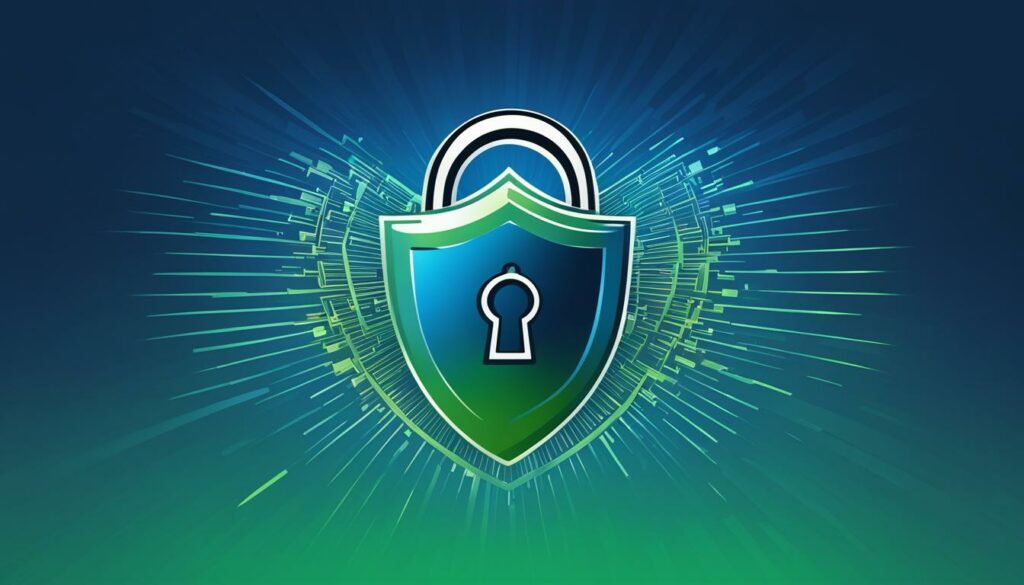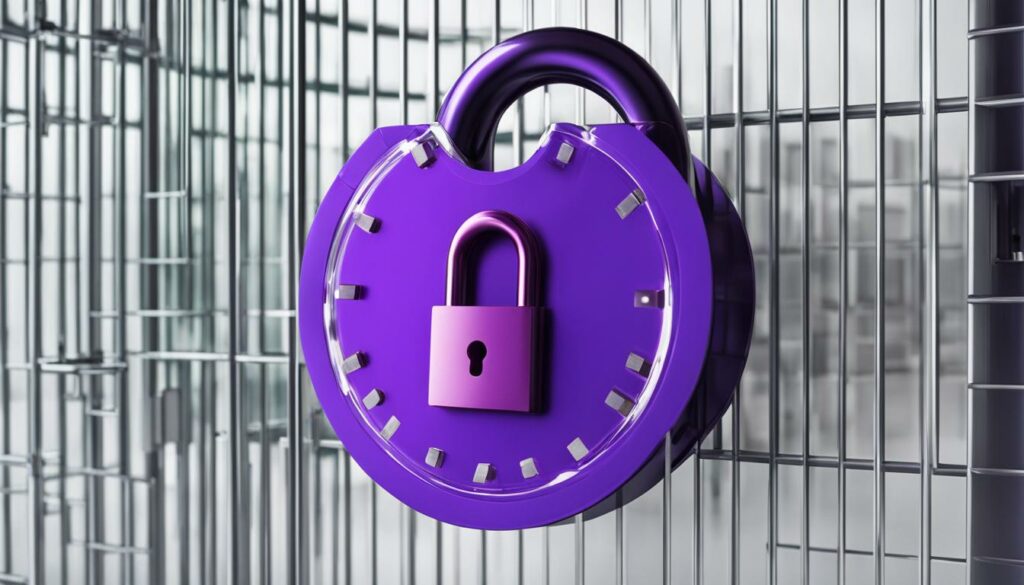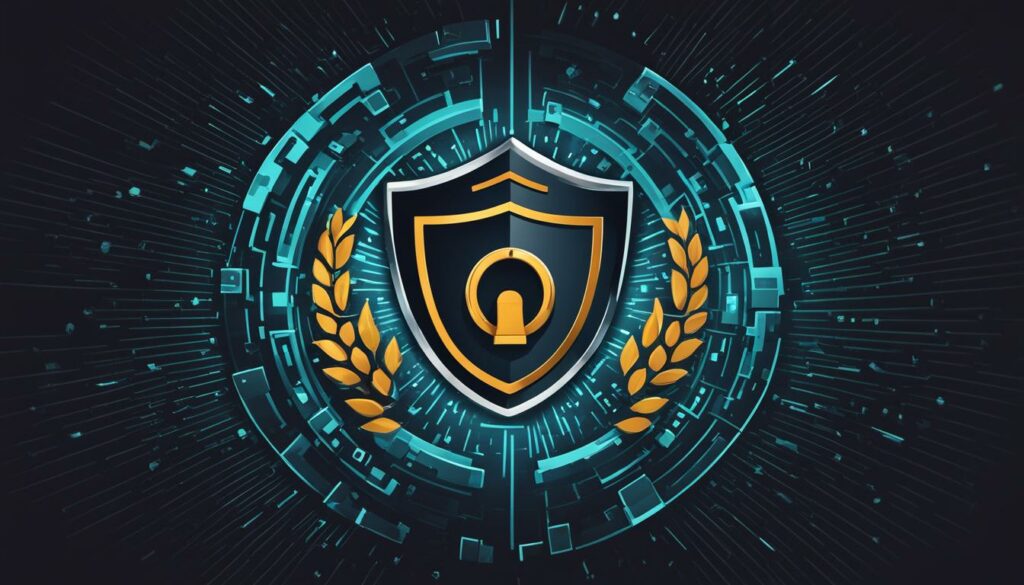Welcome to our article on SSL/TLS encryption! In today’s digital world, where data security is paramount, SSL (Secure Sockets Layer) and its successor TLS (Transport Layer Security) play a crucial role in safeguarding sensitive information. So, what exactly is SSL/TLS and how does it ensure secure communication? Let’s dive in!
Key Takeaways:
- SSL/TLS encryption protects data sent over the internet or a computer network.
- It uses both asymmetric and symmetric encryption to ensure confidentiality and integrity.
- An SSL/TLS certificate is required for websites to enable SSL/TLS encryption.
- SSL/TLS encryption enhances security by preventing unauthorized access and tampering.
- SSL/TLS encryption is widely used for securing web traffic, email communication, and more.
Now that you have a glimpse of what SSL/TLS encryption entails, let’s explore how it works, its importance for data security, the SSL/TLS handshake process, the role of SSL certificates, and more. By the end of this article, you’ll have a comprehensive understanding of SSL/TLS encryption and why it’s vital for maintaining a secure online environment.
How Does SSL/TLS Encryption Work?
In order to understand how SSL/TLS encryption works, let’s break it down into two main components: asymmetric encryption and symmetric encryption. These two techniques work together to establish a secure connection between a client and a server, ensuring that data exchanged within this connection remains private and secure.
Asymmetric encryption plays a crucial role in the initial stages of establishing a secure session. It involves the use of a public key and a private key. The server generates a key pair consisting of these two keys, with the public key being shared openly and the private key being kept secret. When a client wants to initiate a secure connection with the server, it requests the server’s public key.
Once the client receives the public key, it can use this key to encrypt a random session key. This session key is unique to the current session and will be used for symmetric encryption. The client then sends the encrypted session key back to the server.
Upon receiving the encrypted session key, the server uses its private key to decrypt it and obtain the session key. Now that both the client and server have the same session key, they can move on to symmetric encryption.
Symmetric encryption involves the use of a single key, the session key, to encrypt and decrypt data within the secure session. This key is shared by both the client and the server, allowing them to communicate securely. The session key is used to encrypt the data before it leaves the client’s device and decrypt it once it reaches the server.
To enable SSL/TLS encryption, a website must have an SSL/TLS certificate associated with its web server/domain name. The SSL/TLS certificate facilitates the secure negotiation of encryption levels between the client and server. It also plays a crucial role in establishing trust by verifying the legitimacy of the server’s identity.
Here is a simplified overview of the SSL/TLS encryption process:
- The client initiates a secure connection by contacting the server using a secure URL, typically starting with “HTTPS”.
- The server responds by sending its SSL/TLS certificate, which includes its public key and other identifying information.
- The client verifies the certificate’s legitimacy by checking it against a trusted root certification authority.
- Once the certificate is deemed valid, the client uses the server’s public key to encrypt a session key, which is sent back to the server.
- The server decrypts the encrypted session key using its private key, obtaining the session key.
- Both the client and the server now share the same session key, allowing them to communicate securely through symmetric encryption.
By combining asymmetric and symmetric encryption techniques, SSL/TLS encryption ensures the confidentiality and integrity of data transmitted over the internet, providing a secure environment for online communication.
Visual Representation of SSL/TLS Encryption
https://www.youtube.com/watch?v=J7fI_jH7L84
Why is SSL/TLS Encryption Important for Security?
SSL/TLS encryption plays a crucial role in ensuring data security and protecting sensitive information exchanged between a client and server. By implementing SSL/TLS encryption, you enhance the confidentiality and integrity of data communication, safeguarding it from unauthorized access and tampering.
SSL/TLS encryption prevents attackers and Internet Service Providers from viewing or tampering with your data. It creates a secure tunnel that encrypts the information transmitted, making it inaccessible to malicious actors. This is especially important for sensitive data such as login credentials, financial transactions, and personal information.
However, it’s worth noting that SSL/TLS encryption can also be utilized by attackers to hide malicious payloads. This is where SSL/TLS decryption comes into play. Inspection tools such as IDS/IPS, next-gen firewalls, and secure web gateways facilitate SSL/TLS decryption, allowing for the inspection of decrypted data for potential threats and attacks.
SSL/TLS encryption ensures the confidentiality and integrity of data communication, protecting it from attackers. However, it’s important to have the means to decrypt and inspect encrypted data to identify any malicious activities. Inspection tools play a crucial role in maintaining a secure online environment.
With SSL/TLS encryption and proper use of SSL/TLS decryption tools, you can confidently transmit and receive sensitive data without worrying about unauthorized access or tampering.
Inspecting Encrypted Data for Security
SSL/TLS encryption prevents unauthorized access to data, but it can also create challenges for monitoring and securing network traffic. To overcome this obstacle, inspection tools leverage SSL/TLS decryption techniques. These tools intercept encrypted traffic, decrypt it, and inspect it for potential threats before re-encrypting and passing it through to its intended destination.
By decrypting SSL/TLS traffic, inspection tools enable organizations to detect and prevent attacks such as malware, phishing attempts, and data exfiltration. They provide valuable insights into network activity and help maintain a secure environment for users.
Inspecting encrypted data allows organizations to stay one step ahead of attackers, ensuring the confidentiality, integrity, and security of their network and data.
SSL/TLS encryption and inspection tools go hand in hand to provide comprehensive data security. Encrypting data ensures its confidentiality and integrity, while inspection tools allow for the detection and prevention of potential threats.
Next, we will delve into how the SSL/TLS handshake works and the significant role it plays in establishing a secure connection between client and server.
How Does SSL/TLS Handshake Work?
The SSL/TLS handshake is a crucial process that establishes a secure connection between a client and a server. This handshake ensures the confidentiality and integrity of data transmitted over the network. To understand how it works, let’s break down the steps involved:
- The client initiates the handshake by contacting the server and requesting a secure connection.
- The server responds by sending its digital certificate, which includes its public key and other identification details.
- The client verifies the server’s certificate to ensure its authenticity and integrity. This verification process involves checking the certificate’s digital signature and confirming that it is issued by a trusted Certificate Authority (CA).
- If the certificate is valid, the client generates a unique session key and encrypts it using the server’s public key.
- The encrypted session key is sent to the server, which decrypts it using its private key.
- Both the client and server now have the session key, which will be used for symmetric encryption of data during the session.
During the handshake, the client and server also negotiate and select cipher suites. Cipher suites are sets of cryptographic algorithms and security parameters that determine the level of encryption and secure communication protocols.
The SSL/TLS handshake ensures that the client and server can establish a secure connection, authenticate each other’s identities using digital certificates, and exchange a session key for secure data transmission.
Here’s a visual representation of the SSL/TLS handshake process:

What is an SSL Certificate?
An SSL certificate is an essential component of ensuring secure and encrypted communication between a server and a client. It serves as a digital document that verifies the identity of the server and enables encrypted data transmission. By obtaining an SSL certificate, the server undergoes a process of server authentication, proving its legitimacy and association with the organization responsible for it.
How Does an SSL Certificate Work?
The SSL certificate is issued by a trusted Certificate Authority (CA), which acts as an independent third-party entity responsible for verifying the identity of the organization behind the server. The CA conducts a series of checks and validates the information provided by the organization. Once verified, the CA issues a digital certificate that contains the server’s public cryptographic key.
The SSL certificate plays a crucial role in establishing a secure connection. When a client connects to a server with an SSL certificate, it examines the certificate to ensure it is valid and trusted. The client uses the server’s public key to initiate an encrypted communication channel, enabling secure data transfer.
The SSL certificate provides confidence to the client that they are connecting to the legitimate owner of the server and not an impostor or malicious entity. This reassurance is particularly crucial for e-commerce websites, online portals requiring users’ personal information, or any platform that handles sensitive data.
The Role of Certificate Authorities (CAs)
Certificate Authorities (CAs) play a vital role in the SSL certificate ecosystem. They are trusted entities responsible for issuing and managing SSL certificates. CAs have specific trust hierarchies and extensive procedures for verifying the identity of organizations before issuing certificates.
When a client receives an SSL certificate from a trusted CA, they can be confident that the connection to the server is secure and trustworthy. The SSL certificate acts as an assurance mechanism, minimizing the risk of unauthorized access or interception of data during transmission.
Benefits of SSL Certificates
The use of SSL certificates provides several important benefits:
- Increased security: SSL certificates ensure that data transmitted between the server and client remains confidential and protected from unauthorized access.
- Trust and credibility: A website or organization that displays an SSL certificate gains trust from users, demonstrating their commitment to data security and privacy.
- Improved search engine rankings: Search engines, such as Google, prioritize websites with SSL certificates, enabling them to rank higher in search results.
- Protection against phishing attacks: SSL certificates help prevent phishing attacks by verifying the legitimacy of the server and ensuring that users are not connecting to impostor websites.
Having an SSL certificate is essential for any website or online platform that values data security, user trust, and a seamless user experience. By implementing SSL certificates, organizations can establish secure connections, safeguard sensitive data, and build a reputable online presence.
| Benefits of SSL Certificates | Explanation |
|---|---|
| Increased security | SSL certificates ensure encrypted communication, safeguarding data from unauthorized access or interception. |
| Trust and credibility | An SSL certificate instills confidence in users, showcasing a commitment to data security and privacy. |
| Improved search engine rankings | Websites with SSL certificates rank higher in search results, attracting more organic traffic. |
| Protection against phishing attacks | SSL certificates verify the legitimacy of the server, preventing users from falling victim to phishing scams. |

Common Uses of SSL/TLS Encryption
SSL/TLS encryption is essential for securing various aspects of online communication. While it is commonly used for securing web traffic, it also plays a crucial role in ensuring email and usenet security.
When you visit a website that uses SSL/TLS encryption, you will notice that the URL starts with “https” instead of “http.” This indicates that the website is secured and that any data you transmit to it is encrypted. Additionally, most web browsers display a padlock icon in the address bar to further indicate that the connection is secure.

However, SSL/TLS encryption is not limited to web traffic alone. It can also be used to secure other communication channels, such as email and usenet. By encrypting these channels, SSL/TLS ensures that your sensitive data, including emails and usenet posts, remain confidential and protected from prying eyes.
Whether you are sending private emails or participating in usenet discussions, SSL/TLS encryption provides an added layer of defense against potential attackers who may try to intercept or tamper with your communications.
Benefits of SSL/TLS Encryption for Web Traffic:
- Confidentiality: SSL/TLS encryption ensures that sensitive information, such as login credentials and credit card details, remains hidden from unauthorized individuals.
- Data Integrity: SSL/TLS protects against data manipulation during transmission, ensuring that the information you send and receive remains unchanged.
- Trust and Credibility: Websites that use SSL/TLS encryption establish trust with their users by demonstrating their commitment to data security.
Benefits of SSL/TLS Encryption for Email and Usenet Security:
- Confidentiality: SSL/TLS encryption ensures that the content of your emails and usenet posts remains confidential, preventing unauthorized access.
- Data Integrity: SSL/TLS protects against tampering or modifications to your email and usenet communications.
- Secure Authentication: SSL/TLS verifies the identity of the email or usenet server, ensuring that you are communicating with the legitimate entity.
In summary, SSL/TLS encryption is an essential technology for safeguarding web traffic, email communication, and usenet discussions. It provides confidentiality, data integrity, and secure authentication, ensuring that your sensitive information remains protected from potential threats.
Implementing SSL/TLS encryption should be a priority for website owners and anyone who values the security of their online communication. By choosing a reliable SSL/TLS provider, you can establish a secure connection and enjoy peace of mind knowing that your data is protected.
Evolution of SSL/TLS Protocols
The SSL (Secure Sockets Layer) protocol, initially developed by Netscape in the mid-1990s, laid the foundation for secure data transmission over the internet. As the technology progressed, the Internet Engineering Task Force (IETF) standardized the protocol and renamed it as TLS (Transport Layer Security). This evolution brought about significant improvements in security and encryption methods.
One of the notable versions in the SSL protocol series is SSL 3.0, released in 1996. SSL 3.0 introduced several key features and set the stage for future iterations of TLS.
The most recent major version of the TLS protocol is TLS 1.3. As cybercriminal tactics continue to evolve, protocol updates become crucial in ensuring robust security measures. TLS 1.3 is currently being finalized, incorporating advanced encryption techniques and strengthening security against emerging threats.

To stay ahead of cybercriminals, website owners are strongly encouraged to upgrade to TLS 1.3. This protocol update provides enhanced encryption capabilities, ensuring safer data transmission and reducing the risk of unauthorized access. Upgrading to TLS 1.3 protects websites and their users from potential cyber threats.
BoostedHost offers WordPress Hosting services that prioritize the security of your website. Take advantage of optimal performance and reliability by signing up now at www.boostedhost.com/wordpress-hosting.
Vulnerabilities and Updates in SSL/TLS
While TLS 1.2 is the most current version, it does have vulnerabilities that make it susceptible to attacks. These vulnerabilities include man-in-the-middle attacks and specific attack methods like POODLE, SLOTH, and DROWN.
Man-in-the-middle attacks are a common threat in which an attacker intercepts communication between a client and a server to eavesdrop, modify, or inject malicious content. This type of attack can compromise the confidentiality and integrity of data transmitted over the network.
Your confidential information, such as passwords, credit card details, and personal data, could be exposed to malicious actors during a man-in-the-middle attack.
POODLE (Padding Oracle On Downgraded Legacy Encryption), SLOTH (Security Losses from Obsolete and Truncated Transcript Hashes), and DROWN (Decrypting RSA with Obsolete and Weakened eNcryption) are specific vulnerabilities that affect TLS 1.2 and lower versions.
- POODLE: This vulnerability targets the use of SSL 3.0 and can allow an attacker to retrieve sensitive information, such as session cookies, by exploiting the protocol’s weakness.
- SLOTH: SLOTH affects implementations that rely on SHA-1 or MD5 for digital signatures, allowing attackers to weaken the security of SSL/TLS connections.
- DROWN: DROWN is a cross-protocol attack that targets SSLv2 connections, allowing an attacker to decrypt the encrypted TLS traffic.
Fortunately, the industry is actively working on enhancing the security of TLS. TLS 1.3 is being developed to address these vulnerabilities by implementing stronger encryption algorithms and eliminating support for outdated protocols and insecure features.
Table 8.1: Vulnerabilities in TLS 1.2
| Vulnerabilities | Description |
|---|---|
| Man-in-the-Middle Attacks | Attacker intercepts communication to eavesdrop or manipulate data. |
| POODLE | Allows attackers to retrieve sensitive information by exploiting SSL 3.0 weakness. |
| SLOTH | Affects SSL/TLS connections using weak digital signatures (SHA-1 or MD5). |
| DROWN | Decrypts encrypted TLS traffic by exploiting SSLv2 connections. |
Upgrading to TLS 1.3 is crucial for protecting against these vulnerabilities. TLS 1.3 brings significant security improvements, including enhanced encryption, improved handshake protocols, and better protection against attacks.
By staying up-to-date with the latest TLS versions and promptly addressing vulnerabilities, you can ensure the security of your data and maintain the trust of your users.
Conclusion
SSL/TLS encryption is essential for guaranteeing data security and facilitating secure communication across the internet. By encrypting data and establishing secure connections, SSL/TLS shields sensitive information from unauthorized access and manipulation. Implementing SSL/TLS encryption should be a top priority for website owners as it helps protect user data and fosters trust among customers.
Upgrading to the latest TLS protocols is crucial to stay ahead of potential vulnerabilities and maintain a secure online environment. By regularly monitoring for vulnerabilities and promptly applying updates, website owners can ensure the ongoing effectiveness of SSL/TLS encryption in safeguarding data. Prioritizing data security through SSL/TLS encryption helps mitigate risks and safeguards sensitive information from malicious actors.
For optimal performance, we recommend BoostedHost’s WordPress Hosting. Sign up now to enhance your website’s security and performance through SSL/TLS encryption. BoostedHost offers reliable and secure hosting solutions tailored specifically for WordPress, providing you with peace of mind and ensuring a smooth experience for your users.
FAQ
Q: What is SSL/TLS?
A: SSL (Secure Sockets Layer) and its modern replacement, TLS (Transport Layer Security), are encryption protocols that protect data sent over the internet or a computer network. SSL/TLS encrypts communications between clients and servers, primarily web browsers and websites/applications, ensuring secure communication and data security.
Q: How does SSL/TLS encryption work?
A: SSL/TLS encryption uses both asymmetric and symmetric encryption techniques. Asymmetric encryption is used to establish a secure session between a client and a server, while symmetric encryption is used to exchange data within the secured session. To enable SSL/TLS encryption, a website must have an SSL/TLS certificate for their web server/domain name, which allows the client and server to securely negotiate the level of encryption.
Q: Why is SSL/TLS encryption important for security?
A: SSL/TLS encryption enhances security by increasing the confidentiality and integrity of data communication. It prevents attackers and Internet Service Providers from viewing or tampering with the data exchanged between a client and server. However, SSL/TLS encryption can also be used by attackers to hide malicious payloads. To ensure effective security, SSL/TLS decryption is necessary for inspection tools like IDS/IPS, next-gen-firewalls, and secure web gateways.
Q: How does SSL/TLS handshake work?
A: The SSL/TLS handshake is a complex process that occurs when a client contacts a server and requests a secure connection. The handshake involves the exchange of information, including supported cipher suites and a digital certificate that confirms the server’s identity. Using the server’s public key, the client and server establish a session key that will be used for encrypting communication during the session. This handshake process ensures a secure connection and sets the stage for encrypted data transmission.
Q: What is an SSL certificate?
A: An SSL certificate is an electronic document that confirms a server’s identity and enables encrypted communication. It serves as a form of server authentication, verifying that the server is legitimate and associated with the organization offering it. SSL certificates are issued by Certificate Authorities (CAs), which act as trusted third-party entities. CAs verify the identity of organizations and issue certificates that contain the server’s public cryptographic key.
Q: What are the common uses of SSL/TLS encryption?
A: SSL/TLS encryption is commonly used for securing web traffic. When a website uses SSL/TLS encryption, the URL starts with “https,” and there is a padlock indicator in the browser address bar. However, SSL/TLS encryption can also be used for securing other applications, including email and usenet. By encrypting these communication channels, SSL/TLS ensures the confidentiality and integrity of sensitive data exchanged between users and servers.
Q: What is the evolution of SSL/TLS protocols?
A: SSL was the original name of the protocol developed in the mid-1990s by Netscape. It was later standardized by the Internet Engineering Task Force (IETF) and renamed as TLS (Transport Layer Security). The latest major version, TLS 1.3, is currently being finalized due to continuous updates aimed at keeping up with evolving cybercriminal tactics. Website owners are encouraged to upgrade to TLS 1.3 to stay ahead of cyber threats.
Q: What are the vulnerabilities and updates in SSL/TLS protocols?
A: While TLS 1.2 is the most current version, it has vulnerabilities that make it susceptible to attacks. These vulnerabilities include man-in-the-middle attacks and specific attack methods like POODLE, SLOTH, and DROWN. In response to these vulnerabilities, the industry is working on TLS 1.3, which will address these weak points and provide enhanced security. Upgrading to TLS 1.3 is crucial for protecting against these vulnerabilities.
Q: Why is SSL/TLS encryption important for data security?
A: SSL/TLS encryption plays a crucial role in ensuring data security and enabling secure communication over the internet. By encrypting data and establishing secure connections, SSL/TLS protects sensitive information from unauthorized access and tampering. Website owners should prioritize implementing SSL/TLS encryption to safeguard user data and build trust with their customers. Upgrading to the latest TLS protocols and regularly monitoring for vulnerabilities are key steps in maintaining a secure online environment.












